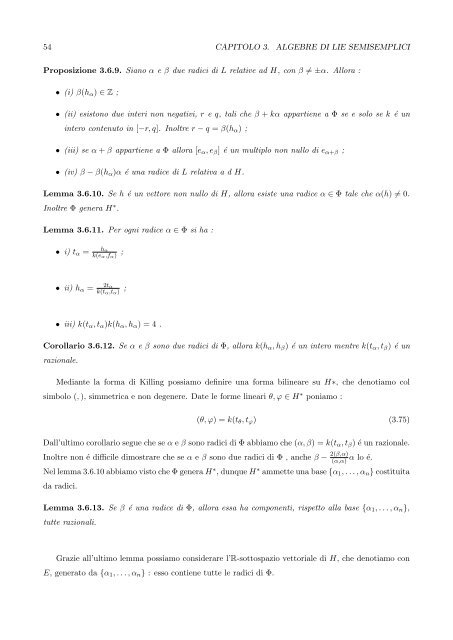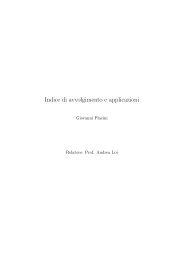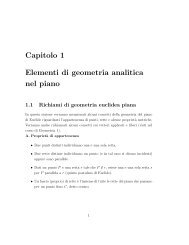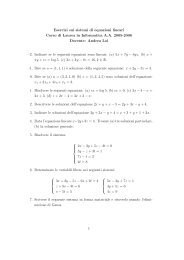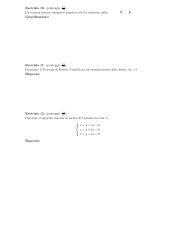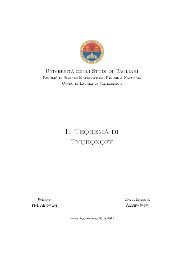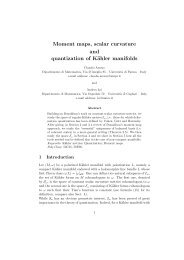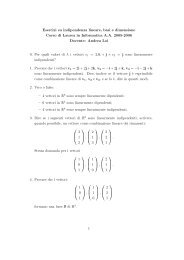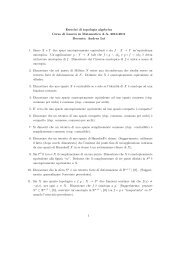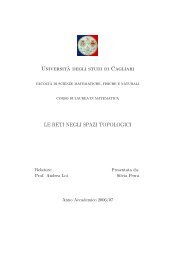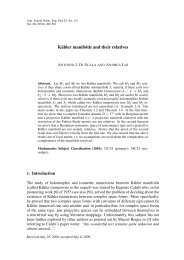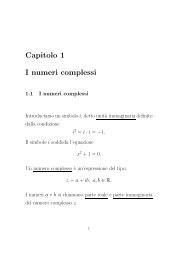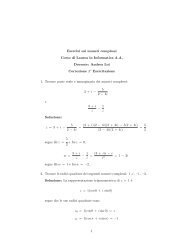Algebre di Lie semisemplici, sistemi di radici e loro classificazione
Algebre di Lie semisemplici, sistemi di radici e loro classificazione
Algebre di Lie semisemplici, sistemi di radici e loro classificazione
You also want an ePaper? Increase the reach of your titles
YUMPU automatically turns print PDFs into web optimized ePapers that Google loves.
54 CAPITOLO 3. ALGEBRE DI LIE SEMISEMPLICI<br />
Proposizione 3.6.9. Siano α e β due ra<strong>di</strong>ci <strong>di</strong> L relative ad H, con β = ±α. Allora :<br />
• (i) β(hα) ∈ Z ;<br />
• (ii) esistono due interi non negativi, r e q, tali che β + kα appartiene a Φ se e solo se k é un<br />
intero contenuto in [−r, q]. Inoltre r − q = β(hα) ;<br />
• (iii) se α + β appartiene a Φ allora [eα, eβ] é un multiplo non nullo <strong>di</strong> eα+β ;<br />
• (iv) β − β(hα)α é una ra<strong>di</strong>ce <strong>di</strong> L relativa a d H.<br />
Lemma 3.6.10. Se h é un vettore non nullo <strong>di</strong> H, allora esiste una ra<strong>di</strong>ce α ∈ Φ tale che α(h) = 0.<br />
Inoltre Φ genera H ∗ .<br />
Lemma 3.6.11. Per ogni ra<strong>di</strong>ce α ∈ Φ si ha :<br />
• i) tα = hα<br />
k(eα,fα) ;<br />
• ii) hα = 2tα<br />
k(tα,tα) ;<br />
• iii) k(tα, tα)k(hα, hα) = 4 .<br />
Corollario 3.6.12. Se α e β sono due ra<strong>di</strong>ci <strong>di</strong> Φ, allora k(hα, hβ) é un intero mentre k(tα, tβ) é un<br />
razionale.<br />
Me<strong>di</strong>ante la forma <strong>di</strong> Killing possiamo definire una forma bilineare su H∗, che denotiamo col<br />
simbolo (, ), simmetrica e non degenere. Date le forme lineari θ, ϕ ∈ H ∗ poniamo :<br />
(θ, ϕ) = k(tθ, tϕ) (3.75)<br />
Dall’ultimo corollario segue che se α e β sono ra<strong>di</strong>ci <strong>di</strong> Φ abbiamo che (α, β) = k(tα, tβ) é un razionale.<br />
Inoltre non é <strong>di</strong>fficile <strong>di</strong>mostrare che se α e β sono due ra<strong>di</strong>ci <strong>di</strong> Φ , anche β − 2(β,α)<br />
(α,α) α lo é.<br />
Nel lemma 3.6.10 abbiamo visto che Φ genera H∗ , dunque H∗ ammette una base {α1, . . . , αn} costituita<br />
da ra<strong>di</strong>ci.<br />
Lemma 3.6.13. Se β é una ra<strong>di</strong>ce <strong>di</strong> Φ, allora essa ha componenti, rispetto alla base {α1, . . . , αn},<br />
tutte razionali.<br />
Grazie all’ultimo lemma possiamo considerare l’R-sottospazio vettoriale <strong>di</strong> H, che denotiamo con<br />
E, generato da {α1, . . . , αn} : esso contiene tutte le ra<strong>di</strong>ci <strong>di</strong> Φ.


